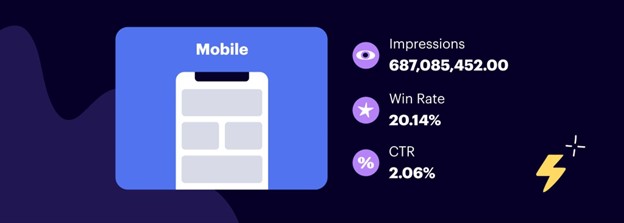Behold, the medium rectangle ad banner (also known as a mid-page unit, or MREC), a wondrous 300x250 pixel digital canvas that has captivated and charmed audiences for years!
A rectangular gem; not too big, not too small; the perfect size to fit any design, especially in the context of limited technical solutions.
For a while, the medium rectangle's dominance was indisputable. MREC was often chosen (and is still) because it's easy to implement, not because it's super effective.
But what's with the past tense?
A recent ad tech report from Epom suggests that the medium rectangle era may be at an end.
In this article, we will delve into the rise and fall of the popular ad format and explore the reasons behind its fading prominence in the ad tech industry.
Epom Ad Tech Study Goals and Results
The study's goal was not to kill the medium rectangle in the public eye, but to identify the most effective strategies for launching programmatic campaigns to help clients and other industry players spend their budgets more efficiently.
Epom analyzed the data of all Epom white-label DSP users from January to December 2022 and highlighted the most popular, best-performing, and most affordable ad banner formats, top used GEOs, and device statistics.
It found that the MREC format is popular on the Epom DSP (and outside of it), but performed worse than expected.

MREC had the biggest number of impressions on the platform, but it was not the best-performing nor the most cost-effective.
We dug deeper and we are now ready to make a statement: The medium rectangle has started to lose ground.
Buckle up—we're about to find out why!
The Medium Rectangle's History and Former Fame
The medium rectangle is a rectangular display ad that typically appears on webpages and inside mobile apps. Its dimensions are usually 300 pixels wide by 250 pixels tall, making it big enough to be noticed but not so intrusive that it disrupts the user experience.

The history of the medium rectangle can be traced back to the early 2000s, when the Interactive Advertising Bureau (IAB) first introduced standardized ad units to streamline digital advertising. Thanks to its versatility and nonintrusive size, MREC swiftly earned its place among the standardized formats.
The medium rectangle's dominance in the ad tech industry can be attributed to a couple of factors.
- First, its size creates a compelling balance between eye-catching visuals and concise messaging, capturing users' attention without overwhelming them. It therefore became the sweet spot for advertisers to deliver their brand message effectively.
- Second, MREC fits almost any website placement, and it is easy to design, saving advertisers time. Programmatic as a real-time ad placement algorithm doesn't assign control over the placement itself. It happens automatically, so MREC, as the most versatile format, has become more commonly used because it fits most placements and doesn't negatively affect the website's UX.
However, as technology evolves, user behavior changes, ad fatigue progresses, and the digital landscape shifts, the limitations of MREC become more apparent.
- One of the major challenges is banner blindness—the tendency of users to ignore display ads altogether, especially when they are accustomed to seeing the same format repeatedly. As users become more ad-savvy, the effectiveness of the medium rectangle has declined because it's standardized and it has been used since the early 2000s.
- Moreover, medium rectangle offers limited creative freedom to design ads with rich media and interactive elements because of its small size. So if you use just a picture in MREC format, it's not really engaging.
Reasons MREC Use Has Declined
As noted earlier, MREC's clickthrough rate was found to be 0.12%,or 7th place in the Epom's study's list of top-performing ad units.
You may think, OK, but its CPM is $0.48, so maybe at least MREC is a cost-effective ad banner size? However, CPC was calculated to measure cost-effectiveness, and surprise: The medium rectangle is not even in the Top 5.
Now let's reflect a bit more to understand the reasons for MREC's potential losses.
1. Emergence of New Ad Formats, Ad Units, and Banner Sizes
Dynamic and interactive ads are taking center stage, so the once-reliable medium rectangle has struggled to keep up. Advertisers have sought more engaging and eye-catching formats, causing an inevitable decline in the effectiveness of traditional banner ads.
2. Mobile Advertising Challenges
The world has become dramatically mobile-centric. Mobile ads perform much better than tablet and desktop ads, statistics show, and the data from the Epom study reflects that.

The focus of digital advertising has shifted to cater to the pocket-sized screens of smartphones. Given limited real estate on mobile devices, advertisers have had to rethink their approach and opt for more compact and responsive ad formats.
That shift took a toll on the medium rectangle, which struggled to fit seamlessly into the narrow confines of mobile screens. The once-versatile banner suddenly faced compatibility issues, and advertisers started searching for alternatives that could perform seamlessly across all devices.
3. Increased Demand for Native Advertising
Native advertising's nondisruptive and integrated approach has gained tremendous popularity among marketers. By mimicking the look and feel of the surrounding content, native ads aim to capture the audience's attention without triggering ad fatigue.
As the demand for native advertising soared, advertisers started diverting their budgets toward more engaging and nonintrusive formats. That diversion further marginalized the medium rectangle's presence, pushing it away from the spotlight.
A Painless Retreat from MREC: What to Try Instead
Although the decline of the medium rectangle might upset some advertisers and challenge them, it also opens up opportunities for those willing to adapt and embrace the changes. Here some tips for moving beyond the medium rectangle.
1. Explore new ad formats
Capitalize on the growing popularity of dynamic and interactive ad formats to engage with your audience on a deeper level. Video ads, dynamic ads based on HTML5, small rectangles (180×150), and mobile banners (320x50) are just a few examples of captivating ad formats that can yield impressive results.
2. Embrace native advertising
Native ads blend seamlessly with a website's content and user experience, making them less intrusive and more effective than traditional display ads. Also, native banners are not as resource-consuming in their design and require only a template on the publisher's website.
3. Prioritize mobile advertising
Most Internet users are now absorbing content on mobile devices, so advertisers must prioritize mobile-friendly ad formats, such as playable ads, interstitials, and popup banners.
* * *
New ad formats have emerged, user behaviors have changed, and the focus has shifted toward mobile and native advertising, so the medium rectangle is facing considerable challenges to remaining relevant and impactful.
However, it can still fit snugly in articles or blog posts, pop up inside tablet games, and appear on any website, offering relevant content suggestions or products. That's why we won't pronounce its dramatic death quite yet.
The key to advertising success is staying agile and adaptive as technology evolves. So, although the medium rectangle's reign might be fading, the future of digital advertising is brimming with exciting possibilities.
More Resources on Ad Tech Trends and Display Ads
Eight Ad Tech Innovators' Hopes and Expectations
Optimize Display Ads With Consumer Insights: Stats and Best-Practices [Infographic]




